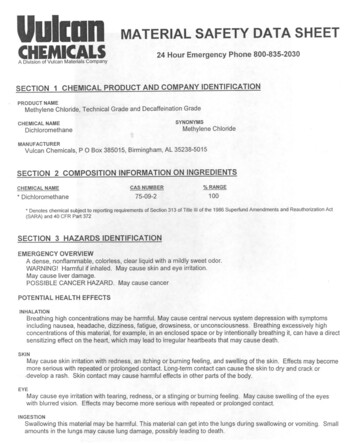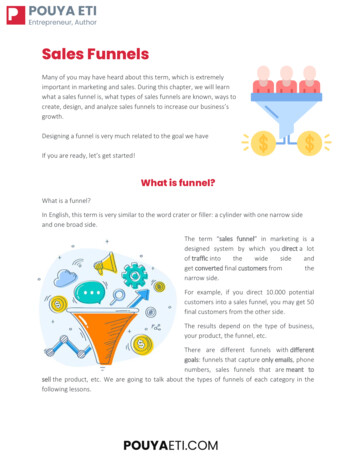
Transcription
UollanCHEMICALSMATERIAL SAFETY DATA SHEET24 Hour Emergency Phone 800-835-2030A Division of Vulcan Materials CompanySECTION 1 CHEMICAL PRODUCT AND COMPANY IDENTIFICATIONPRODUCTNAMEMethylene Chloride, Technical Grade and Decaffeination GradeSYNONYMSCHEMICAL NAMEDichloromethaneMANUFACTURERVulcan Chemicals,Methylene ChloridePOBox385015,Birmingham,AL 35238-5015SECTION 2 COMPOSITION INFORMATION ON INGREDIENTSCHEMICAL NAME* DichloromethaneCAS NUMBER75-09-2% RANGE100.Denotes chemical subject to reporting requirements of Section 313 of Title III of the 1986 Superfund Amendments and Reauthorization Act(SARA) and 40 CFR Part 372SECTION 3 HAZARDS IDENTIFICATIONEMERGENCY OVERVIEWA dense, nonflammable, colorless, clear liquid with a mildly sweet odor.WARNING! Harmful if inhaled. May causeskin and eye irritation.May cause liver damage.POSSIBLE CANCER HAZARD. May cause cancerPOTENTIAL HEALTH EFFECTSINHALATIONBreathing high concentrations may be harmful. May cause central nervous system depression with symptomsincluding nausea, headache, dizziness, fatigue, drowsiness, or unconsciousness. Breathing excessively highconcentrations of this material, for example, in an enclosed space or by intentionally breathing it, can have a directsensitizing effect on the heart, which may lead to irregular heartbeats that may cause death.SKINMay cause skin irritation with redness, an itching or burning feeling, and swelling of the skin. Effects may becomemore serious with repeated or prolonged contact. long-term contact can cause the skin to dry and crack or,develop a rash. Skin contact may cause harmful effects in other parts of the body.EYEMay cause eye irritation with tearing, redness, or a stinging or burning feeling. May cause swelling of the eyeswith blurred vision. Effects may become more serious with repeated or prolonged contact.INGESTIONSwallowing this material may be harmful. This material can get into the lungs during swallowing or vomiting. Smallamounts in the lungs may cause lung damage, possibly leading to death.
UolEanMATERIAL SAFETY DATA SHEETMethylene Chloride, TechnicalCHEMICALS.10/1/04Page2 of 8SIGNSANDSYMPTOMSOFEXPOSUREDepending upon level and duration of exposure, other possible signs and symptoms from breathing, swallowing,and/or entry of this material through the skin include: numbness or tingling feeling, irritation of the nose, throat,airways, and lungs with cough, stomach or intestinal upset with pain, nausea, vomiting, and/or diarrhea, centralnervous system depression with nausea, headache, dizziness, fatigue, drowsiness or unconsciousness,anesthesia, confusion, loss of memory, irregular heartbeats (which may lead to loss of consciousness and death)and carboxyhemoglobinemia (blood abnormality which may lead to unconsciousness)MEDICALCONDITIONSAGGRAVATEDBY EXPOSUREPreexisting disorders of the following organs or systems which may be aggravated by exposure to this materialinclude: respiratory system (including asthma and other breathing disorders), nervous system, liver, kidney, andcardiovascular system. YConsumption of alcoholic beverages may increase potential for development of toxic effects resulting from exposureto this product.Carboxyhemoglobin levels can be elevated in persons exposed to methylene chloride and can cause a substantialstress on the cardiovascular system. This elevation can be additive to the increase caused by smoking and othercarbon monoxide sources.EFFECTSFOllOWINGREPEATEDEXPOSUREThis material may cause the following effects depending upon level and duration of exposure: nervous systemeffects, liver damage. Observations in animal studies include effects on kidneys and blood. The relevance of theseobservations to humans is not clear at this time.CARCINOGENICITYMethylenechloride is listed on the IARC and NTP carcinogenlists. See Section11 for additionalinformation.MUTAGENICITYThis materialis a mammaliansomaticcell mutagen.See Section 11 for additional toxicological information.SECTION 4 FIRST AID MEASURESINHALATIONIf symptoms develop, remove individual to fresh air and get medical attention. If breathing is difficult, give oxygen.If breathing stops, give artificial respiration.SKINWash exposed skin well with plenty of soap and water. Remove contaminated clothing and shoes. Wash clothingand thoroughly clean shoes before reuse. If symptoms develop and continue, get medical attention.EYESHold the eyelids apart and flush the eye gently with a large amount of water for at least 15 minutes. Get medicalattention if irritation persists or if there are any effects on V!Sion.INGESTION.Do not induce vomiting unless directed to do so by medical personnel -- this material is an aspiration hazard. Getimmediate medical attention. Never give anything by mouth to an unconscious person.NOTESTOPHYSICIANThis material sensitizes the heart to the effects of sympathomimetic amines. Epinephrine and othersympathomimetic drugs may initiate cardiac arrhythmias in individuals exposed to this material.This material is an aspiration hazard. Risk of aspiration must be weighed against possible toxicity of the material(see 'ingestion') when determining whether to induce emesis or to perform gastric lavage.
UulEan.MATERIALCHEMICALSSAFETY DATA SHEETMethyleneChloride,Technical10/1/04Page 3 of 8SECTION 5 FIRE FIGHTINGMEASURESFLAMMABLE PROPERTIESAUTOIGNITIONTEMPERATUREFLASH POINT556 C (1032 F)None (TCC)FLAMMABLE LIMITS IN AIR (PERCENT BY VOLUME)12 -19% (Vol.) @ 100 ene,chlorine.EXTINGUISHINGMEDIAWater spray, dry chemical,foam, carbon dioxide.FIREFIGHTINGINSTRUCTIONSConcentrated vapors can be ignited by high intensity energy source. Approach fire from upwind to avoid hazardousvapors and toxic decomposition products. Use water spray to keep fire-exposed containers cool. Extinguish fireusing an agent suitable for surrounding fire.Firefighters should wear full protective clothing and use positive pressure, full-face piece SCBA.SECTION 6 ACCIDENTAL RELEASE MEASURESEvacuate the area, ventilate, and avoid breathing vapors. Dike area to contain spill. If spill occurs indoors, turn offheating and/or air conditioning systems to prevent vapors from contaminating entire building. Clean up area (wearprotective equipment - refer to Section 8) by mopping or with absorbent material and transfer to closed containersfor disposal. Avoid contamination of ground and surface waters. Do not flush to sewer. All spills or leaks of thismaterial must be handled and disposed of in accordance with Federal, state and local regulations.Notify National Response Center (800/424-8802), and any state and local agencies as applicable, of uncontainedreleases to the environment in excess of the EPA Reportable Quantity (RQ). See Section 15 for regulatoryinformation.For all transportation accidents, call CHEMTREC at 800/424-9300.SECTION 7 HANDLING AND STORAGEHANDLINGAvoid contact with eyes, skin and clothing. Avoid breathingvapors. Do not taste or swallow.Do not eat, drink, orsmoke in work area. Wash hands prior to eating, drinking, or using restroom. Any clothing or shoeswhich becomecontaminatedwith methylenechloride should be removedimmediatelyand thoroughlylaunderedbeforewearingagain.Carefully monitor handling, use and storage to avoid spills and leaks. Follow protective controls set forth in Section8 when handling this product. Do not use in poorly ventilated or confined spaces. Vapors are heavier than air andwill collect in low areas. Do not enter confined spaces such as tanks or pits without following proper entryprocedures as required by 29 CFR 1910.146.STORAGESTORAGECONDITIONSStore in labeled and sealed containers in a cool, dry, well-ventilated area out of sunlight. Keep containers tightlyclosed when not in use. Do not store in open, unlabeled or mislabeled containers. Do not remove or deface label.Prevent water or moist air from entering storage tanks or containers.Do not reuse drum without recycling or reconditioning in accordance with any applicable Federal, state or local laws.Do not use cutting or welding torches, open flames, or electric arcs on empty or full containers.
UolEanMATERIALCHEMICALSSAFETY DATA SHEETMethylene Chloride, Technical10/1/04Page4 of 8SHELF LIFE LIMITATIONSMethylenechloridehas an indefiniteshelf life when stored under AGEORTRANSPORTAlumiflum equipment should not be used for storage and/or transfer. Contact with aluminum parts in apressurizable fluid system may cause violent reactions. Consult equipment supplier for further information.SECTION 8 EXPOSURE CONTROLS! PERSONAL PROTECTIONENGINEERINGCONTROLSVENTILATIONDo not use in poorly ventilated or confined spaces. Open doors and/or windows. Use ventilation to maintainexposure levels below 25 ppm time-weighted average (TWA). Monitoring should be performed as required by 29CFR 1910.1052 to determine exposure level(s). See Exposure Guidelines below.PERSONAL PROTECTIVE EQUIPMENTEYE AND FACE PROTECTIONWear safety glasses. Contact lenses should not be wom. Facial protection, such as chemical goggles and faceshields should be worn where splashing is possible.SKIN PROTECTIONWear solvent-resistant gloves such as Viton or equivalent. Solvent-resistant boots, aprons and full face protectionshould be worn where splashing is possible.RESPIRATORYPROTECTIONWhere vapor concentration exceeds or is likely to exceed 25 ppm, a NIOSH-approved, continuous flow supplied airrespirator, hood or helmet is acceptable. A NIOSH approved self-contained breathing apparatus or supplied-airrespirator, with a full-face piece, is required for vapor concentrations above 625 ppm. A NIOSH approvedself-contained positive pressure breathing apparatus, with full-face piece, is required for spills and/or emergencies.The minimumrequirementsfor respiratoryprotectionfor methylenechlorideappear in 29 CFR 1910.1052 (t).GENERALSafety shower and eyewash station should be available. Protective equipment and clothing should be selected,used, and maintained according to applicable standards and regulations. For further information, contact theclothing or equipment manufacturer.EXPOSURE GUIDELINESThe OSHA Occupational Health Standard for methylene chloride (29 CFR Part 1910.1052) covers all occupationalexposures to methylene chloride. In addition to exposure limits, the standard also establishes an action level whichtriggers the requirement for additional compliance activities including medical surveillance.ACGIH: 50 ppm TWA (8 hr)(Based on CNS and anoxia effects)OSHA: 25 ppm TWA (8 hr)125 ppm STEl12.5 ppm (8 hr TWA) Action levelIMMEDIATELYDANGEROUSTO LIFE OR HEALTH2300 ppmODORTHRESHOLDOdor threshold approximately 200-300 ppm; causes olfactory fatigue (temporary loss of odor perception for thisproduct).
UolEanMATERIALCHEMICALSSAFETY DATA SHEETMethyleneChloride,Technical10/1/04Page 5 of 8SECTION 9 PHYSICALAND CHEMICAL zAPPEARANCE AND ODORColorless, clear liquid; mildly sweet odorSPECIFICGRAVITYVAPOR PRESSUREVOLATILES, PERCENTBY VOLUME1001.32 @ 25/25 C350 mm Hg @ 20 CVAPOR DENSITYBOILING POINT40.1 C.2.9(104 F.)SOLUBILITY IN WATEREVAPORATIONRATE1.32 gm/100 gm @ 25 C(ether 1): 0.7SECTION 10 STABILITY AND REACTIVITYCHEMICAL STABILITYStableCONDITIONSTO AVOIDAvoid contact with open flame, electric arcs, or other hot surfaceswhich can cause thermaldecomposition.INCOMPATIBILITYWITH OTHERMATERIALSStrongalkalies,oxygen, nitrogenperoxide,sodium, potassium,and other oxidizersand reactive ide,phosgene,chlorine.HAZARDOUS POLYMERIZATIONWill not occurSECTION 11 TOXICOLOGICAL INFORMATIONACUTE TOXICITYANIMAL TOXICOLOGYInhalation LCso:Dermal LDso:Oral LDso:14,400 ppm - 7 hours (mouse)Not determined2,100 mg/kg (rat)INHALATIONCase studies of methylene chloride poisonings during industrial operations have demonstrated that inhalationexposure can be fatal to humans. Death appears be caused by narcosis and respiratory depression due to the acuteeffects of high concentration methylene chloride on the central nervous system. Concentrations greater than 50,000ppm are regarded as immediately threatening to life. Studies indicate that methylene chloride is metabolized tocarbon monoxide. Consequently, elevations in carboxyhemoglobin as high as 50% have been reported, and levelsmay continue to rise for several hours after exposure has ceased. Data in experimental animals also suggest thereis a narrow margin between concentrations causing anesthesia and death.EFFECTS FOllOWING REPEATED EXPOSUREA number of human and animal inhalation studies demonstrate that methylene chloride can produce nervoussystem effects at below lethal inhalation doses. Experimental and occupational studies report alterations inbehavioral performance and various psychomotor tasks following exposure to methylene chloride. Other neurotoxiceffects noted in occupational studies included dizziness, headaches, nausea, memory loss, paresthesia, tingling inhands and feet, and loss of consciousness. Dementia and gait impairment were reported in one case in humansfollowing exposure to methylene chloride (500-1,000 ppm) for 3 years.
UolEanMATERIAL SAFETY DATA SHEETCHEMICALSMethylene Chloride, Technical10/1/04Page6 of 8Findings from animal studies include evidence of liver and kidney damage. In rats, cats, dogs, and guinea pigs,oral or inhalation exposure to methylene chloride has resulted in liver necrosis, fatty changes and elevated plasmaenzymes. Renal tubular vacuolization and/or nonspecific renal tubular degenerative and regenerative change wereobserved in dogs, rats, and/or mice following chronic inhalation exposures.Exposure to methylene chloride also has been associated with changes in the blood. In occupationally exposedwomen (but not men), methylene chloride at concentrations up to 475 ppm was associated with increases in thered cell count, hemoglobin, and hematocrit. Similar findings were observed in rodents exposed orally for 3 months,but not in rodents chronically exposed by inhalation at concentrations up to 3,500 ppm. In mice and rats,methylene chloride in drinking water for 2 years produced an increase in the number of leukocytes, red blood cells,hematocrit and hemoglobin levels.CARCINOGENICITYSeveral epidemiological studies have detected no excess risk of death from malignant neoplasms in workersexposed to methylene chloride at levels up to 475 ppm. In 1999, the US Agency for Toxicological Studies andDisease Registry reviewed all of these studies and concluded: "Epidemiological studies of human occupationalcohorts show no increase in cancer of the lung, liver, or any other organs from occupational inhalation exposure.»Animals exposed via inhalation have demonstrated that methylene chloride can increase the incidence of naturallyoccurring tumors. In mice and rats, inhalation of very high levels of methylene chloride increases the incidence ofliver and lung cancer and benign mammary gland tumors. Rats also had an increased incidence of salivary glandsarcoma and leukemias. The incidence of liver tumors that appeared in mice after exposure to concentrations of2,000 ppm or greater was also higher than controls.The International Agency for Research on Cancer (IARC) has concluded that, with respect to methylene chloride,there is sufficient evidence of the carcinogenicity to experimental animals and inadequate evidence forcarcinogenicity to humans (Group 2B: Possibly carcinogenic to humans). NTP has classified methylene chloride asreasonably anticipated to be a human carcinogen. ACGIH classifies methylene chloride as an A3 - "ConfirmedAnimal Carcinogen with Unknown Relevance to Humans." Recent evidence suggests that polymorphisms in genesthat metabolize methylene chloride may be associated with an increased risk of cancer in humans.GENOTOXICITYMethylene chloride has been evaluated for its potential to induce genotoxic effects in both in vivo and in vitrosystems in mammalian and bacterial cells with mixed results. Based on this evidence, methylene chloride may beconsidered to be a weak mutagen in mammalian systems. .DEVELOPMENTALTOXICITYIn general, studies in animals indicate that methylene chloride causes minor fetal effects at relatively high dosesthat also affect the mother. It appears that the maternal liver metabolizes methylene chloride at a higher rate thanthe fetus, but that the metabolite carbon monoxide equilibrates between the dam and fetus. The high affinity of fetalhemoglobin for both carbon monoxide and oxygen suggests that fetuses may be at risk from hypoxia followingmaternal exposures to high levels of methylene chloride.Reports suggesting a possible increased risk of spontaneous abortion among women exposed to methylenechloride have been found to have significant flaws. Another study using estimated exposure data and birth weightsin various census tracts did not find an association between possible methylene chloride exposure and birth weight.Methylene chloride is metabolized to carbon monoxide and results in increased carboxyhemoglobin levels in bothanimals and humans. In pregnant women, carbon monoxide poisoning is associated with intrauterine fetal deathand with neurological deficits in surviving infants; however, toxicity of this sort has been seen only when thepoisoning has been severe enough to cause maternal symptoms.
UolEanMATERIALCHEMICALSSAFETY DATA SHEET10/1/04Methylene Chloride, TechnicalPage7 of 8SECTION 12 ECOLOGICAL INFORMATIONENVIRONMENTALFATEWater: Methylene chloride in water is subject to rapid evaporation, with estimated evaporative half-lives ranging from3 to 5.6 hours under moderate mixing conditions. Hydrolysis is not significant in water under normal environmentalconditions. Biodegradation may occur in groundwater, but will be very slow compared with evaporation. Methylenechloride is not ex()ected to bioconcentrate, with an estimated bioconcentration factor of 5. Henry's Law Constant is3.19 x 10-3atm m3/mol.OctanollWater Partition Coefficient (log Kow) is 1.25Soil: Methylene chloride is expected to evaporate rapidly from near-surface soil. It is probable that methylenechloride can leach through subsoil into groundwater. Soil adsorption potential is low. Calculated AdsorptionCoefficient (log Kod is 1.68.Air: Methylene chloride in the atmosphere will degrade by reaction with hydroxyl radicals, with a half-life of severalmonths. It is not subject to direct ow-through) for Fathead Minnow:static) for Fathead Minnow:static) for Bluegill:for Mysid Shrimp193 mg/L310 mg/L220 mg/L @ 21-23 C256 mg/LSECTION 13 DISPOSAL CONSIDERATIONSAll disposals of this material must be done in accordance with Federal, state and local regulations. Wastecharacterization and compliance with disposal regulations are the responsibilities of the waste generator.SPILLRESIDUESRecovered liquids may be sent to an EPA permitted redaimer or incineration facility. Contaminated material mustbe disposed of in a permitted waste management facility. Do not dump into any sewers, on the ground, or into anybody of water. Any disposal must be in compliance with Federal, state, or local regulations.SECTION 14 TRANSPORT INFORMATIONDOT IDENTIFICATIONNO.UN 1593DOT SHIPPINGDESCRIPTION(49 CFR 172.101)Dichloromethane,6.1, UN 1593, PG Ifl, RQPLACARD REQUIREDPOISON, 1593, Class 6LABELREQUIREDPOISON, Class 6Label as required by OSHA Hazard Communication Standard and any applicable state and local regulations.IMOREQUIREMENTSEmS No.: 61.02SECTION 15 REGULATORY INFORMATIONU S FEDERAL REGULATIONSOCCUPATIONALSAFETY AND HEALTH ADMINISTRATION(OSHA)Occupational exposures to methylene chloride are regulated under 29 CFR 1910.1052.
UollanMATERIAL SAFETY DATA ge 8 of 8REPORTABLE QUANTITY(RQ)Reportable Quant
heating and/or air conditioning systems to prevent vapors from contaminating entire building. Clean up area (wear protective equipment-refer to Section 8) by mopping or with absorbent material and transfer to closed containers for disposal. Avoid contamination of ground and surface w











